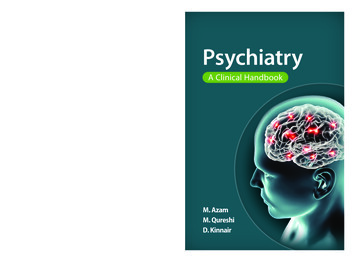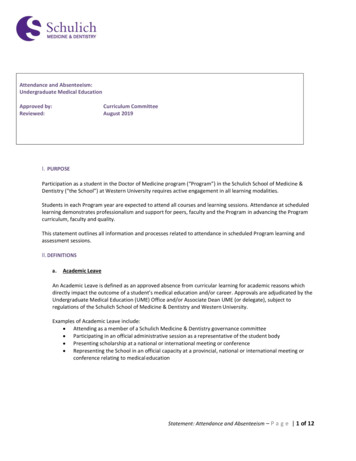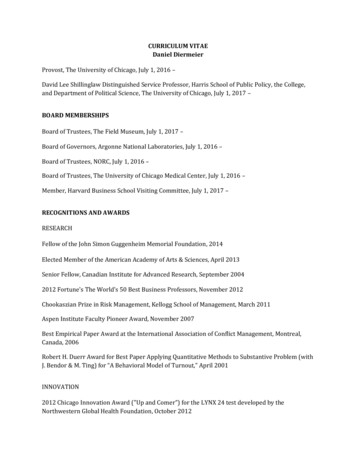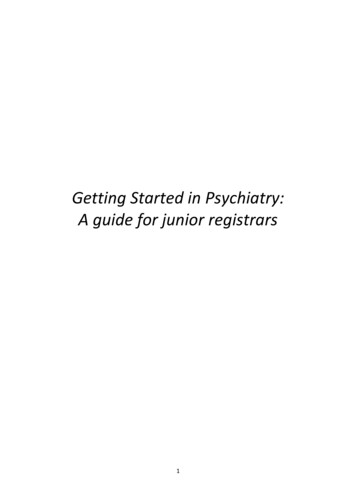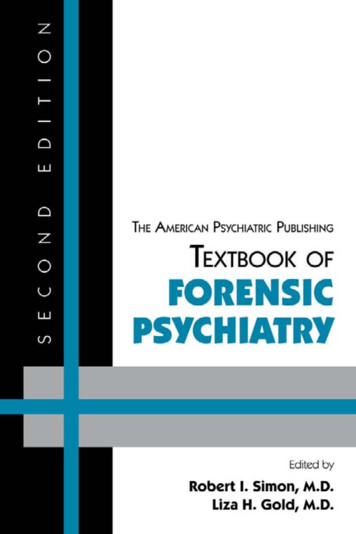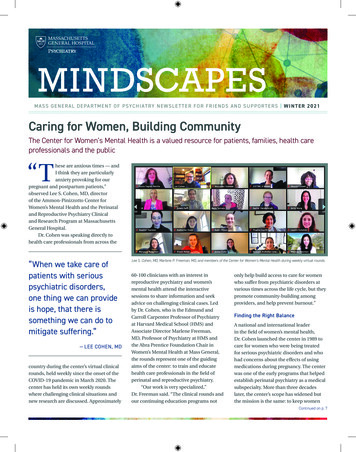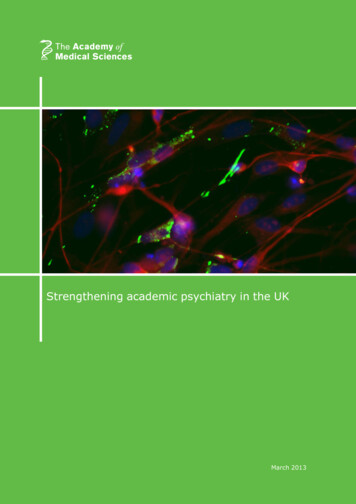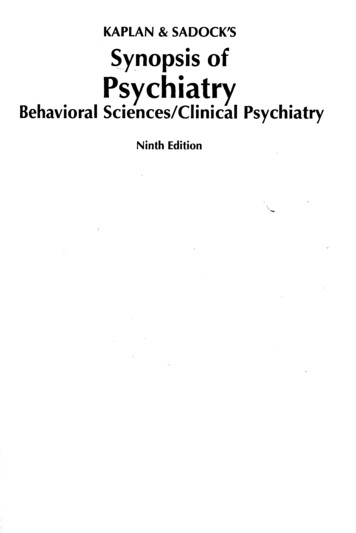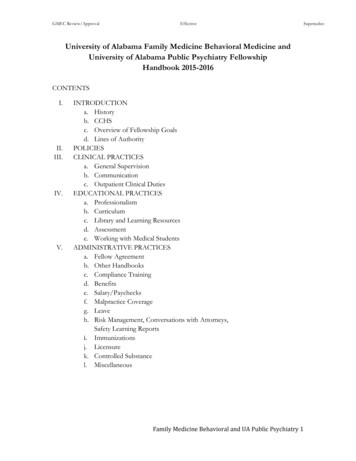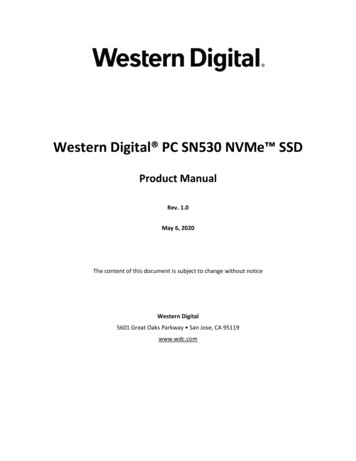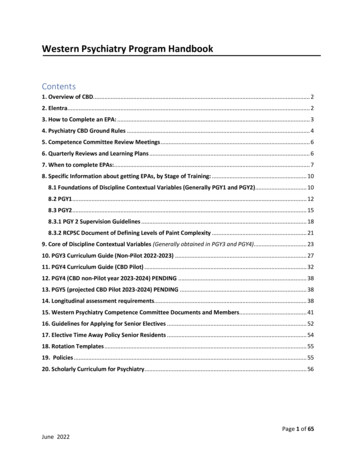
Transcription
Western Psychiatry Program HandbookContents1. Overview of CBD. 22. Elentra. 23. How to Complete an EPA: . 34. Psychiatry CBD Ground Rules . 45. Competence Committee Review Meetings . 66. Quarterly Reviews and Learning Plans . 67. When to complete EPAs:. 78. Specific Information about getting EPAs, by Stage of Training: . 108.1 Foundations of Discipline Contextual Variables (Generally PGY1 and PGY2) . 108.2 PGY1 . 128.3 PGY2 . 158.3.1 PGY 2 Supervision Guidelines . 188.3.2 RCPSC Document of Defining Levels of Paint Complexity . 219. Core of Discipline Contextual Variables (Generally obtained in PGY3 and PGY4). 2310. PGY3 Curriculum Guide (Non-Pilot 2022-2023) . 2711. PGY4 Curriculum Guide (CBD Pilot) . 3212. PGY4 (CBD non-Pilot year 2023-2024) PENDING . 3813. PGY5 (projected CBD Pilot 2023-2024) PENDING . 3814. Longitudinal assessment requirements. 3815. Western Psychiatry Competence Committee Documents and Members. 4116. Guidelines for Applying for Senior Electives . 5217. Elective Time Away Policy Senior Residents . 5418. Rotation Templates . 5519. Policies . 5520. Scholarly Curriculum for Psychiatry. 56Page 1 of 65June 2022
1. Overview of CBDCompetence by Design (CBD) is a competency-based training model developed by the RCPSC for allresidency programs across the country. Psychiatry residency programs are in a CBD model starting withthe cohort who entered PGY1 in July 2020.Those who are in a CBD program should already know the basics of how CBD works from other sources.If you are unfamiliar with EPAs, milestones and competencies, please follow these links to the relevantdocuments:-Overview of Competence by Design (CBD), pdf-RCPSC Psychiatry Competencies 2020-Table of EPAs-RCPSC Psychiatry EPAs 2020-Elentra users guide: https://www.schulich.uwo.ca/cbme/docs/PGME Elentra User Guide.pdf- Schulich Assessment and Appeals Policy-All other Schulich policy documents-Residents and supervisors should be familiar with these documents and the informationcontained in them. They may be referred to for answers to many training and CBD-relatedquestions.-The information contained within this document should be considered the most up-to-datesource on resident requirements for the psychiatry residency program.-This information will be updated at least annually by each June based on updates to RCPSC andSchulich policies and changes to the curriculum based on results, feedback and therecommendations of the Evaluation and Assessment committees. This document and links toother documents will also be updated as necessary to reflect any major changes.2. ElentraElentra is the platform and e-portfolio for EPA assessments.EPA forms are filled in on Elentra, using a computer or a mobile device.An icon can be created for the desktop of your mobile device, making it easy to access assessments.There are different options for residents to send out EPA assessments to a supervisor and supervisorscan also initiate an EPA on their own.Page 2 of 65June 2022
Supervisors can create a PIN on Elentra. This allows residents to fill out initial portions of the EPA beforepassing the same device to supervisors where they login to complete their portion and sign off on theform.Full, detailed instructions can be found in the Elentra users guide:https://www.schulich.uwo.ca/cbme/docs/PGME Elentra User Guide.pdf3. How to Complete an EPA:1. Resident and/or consultant identify a clinical encounter that is suitable for one of theEPAs, before a clinical contact takes place.In some settings, such as the emergency department, this would be done in themoment, before seeing a new patient. In other clinical settings it could beplanned the day before or at the start of the clinical day.2. The resident or supervisor communicates to the other that they would like to do an EPAassessment for the selected clinical encounter.3. Eithera. The resident logs into Elentra and sends an EPA request to the supervisor (seethe Elentra guide and CBD Ground Rule for more information) orb. The supervisor logs into Elentra and selects the resident and the EPA, filling outany parts of the EPA that can be completed prior to the EPA observation andsaving the partially completed form.(Note: this can also be done after the clinical assessment takes place but it isoften helpful to have the EPA and milestones available for reference before theclinical encounter)4. The resident performs the clinical task, usually with the supervisor present (unless it isone of the few EPAs where indirect observation is possible)5. The supervisor gives the resident feedback about the performance of the clinical task,ideally referencing the EPA form while filling it out with the same feedback.6. The supervisor signs off on the EPA form.Page 3 of 65June 2022
4. Psychiatry CBD Ground RulesEntrustable Professional Activities (EPAs)-Ideally, an EPA should be completed at every possible opportunity.ooo-Recognizing that observation is not always possible when opportunities exist, expectedminimums have been set to facilitate the accomplishment of observations andentrustable EPAsThe expected number of EPA observations is set by the residency program. Thesetargets are to set to help ensure that residents have enough opportunities for EPAobservation to obtain entrustability for all the contextual variables. The contextualvariables and required number of entrustable EPAs are set by the RCPSC Psychiatryspecialty committee. It is necessary for residents to ensure that they have attainedentrustability for all the required contextual variables. This may mean residents need toexceed the expected minimum number of observations set by the residency program ifentrustability is not obtained in earlier attempts of EPAs.Observations should be done on a regular basis, even if the resident is not confidentthat they are yet entrustable, so that they can get direct feedback on theirperformance.The completion of an EPA is a shared expectation of residents and consultants.ooooResidents are expected to send an EPA form to their supervisor at the time anopportunity to complete a particular EPA is identified, orIf an observed clinical consult is planned, the EPA form should be sent before the clinicstarts, so it is ready at the time of assessment.An EPA request cannot be sent if it was not discussed with the consultant at the timeof direct observation and must be sent by the end of the day that the clinicalencounter took place.It is the resident’s responsibility to ensure that they complete enough EPAassessments to fulfill the RCPSC requirements (attaining entrustability for a sufficientnumber of EPAs as well as fulfilling the required contextual variables)-An EPA should be completed by the consultant within one week (7 days) of the time it wassent.o While timely completion of EPA assessment forms on Elentra is expected ofconsultants, it is recommended that residents follow-up with the consultant on anyEPA assessments that have not been completed within 5 days of the observed clinicaltask. If there are repeated challenges in getting EPA forms completed, please bringthis to the attention of the CBD Lead (Dr. Thomson) or a Program Director.-Which EPAs may be filled by PGY5 residents is outlined on the EPA forms as designated by theRCPSC Psychiatry specialty committeePage 4 of 65June 2022
-Residents should complete as much of the patient and clinical information as possible on theEPA form before sending it to the supervisor. In some situations, this may not be possible andcan be decided on a case-by-case basis by the resident and consultant. This clinical informationis required to satisfy contextual variable requirements so it is very important that it be addedaccurately.-In some cases, the consultant may ask the resident to complete a separate self-assessment. Inthese circumstances the consultant must still complete the milestone ratings and narrativefeedback.-A rating of 4 or 5 on the entrustability scale is considered entrustable for psychiatry EPAsGround Rules regarding Schulich Psychiatry Clinical Competence Committee (CCC)-Currently there are at least 5 members of the competence committee who are also on the RPC.This number is subject to change.-Reviewers are rotated at each review, in order to have “a fresh set of eyes” on each residentfile.-There are no non-psychiatry members of the committee. This may be subject to review in thefuture.-There may be a subspecialty R6 resident on the committee, when available.-The entire file is reviewed for the time period since the last CC meeting, including theLongitudinal assessment requirements, listed in this guide, which is updated regularly.-The PGE office sends a reminder to residents to submit materials at least 4 weeks before the CCmeets. Residents must submit the required items at least 2 weeks prior to the CC meeting.-Progress letters are sent out after the RPC approves the progression status of each resident.-Appeals occur in accordance with the Schulich PGME Assessment and Appeals Policy-The following may be appealed, in accordance with the policy:ooooooa Summative Assessment of “Failing to Progress” from a Competence Committeea decision that the Resident’s remediation program was unsuccessfula refusal to promote the Resident to the next level or stage of traininga refusal by an RPC to complete a FITAR or CITAR certifying that the Resident hasacquired the competencies of the specialty/subspecialty, or to affirm Resident’sreadiness for independent practicedismissal following an unsuccessful probation programa decision by the Associate Dean PGME to dismiss a Resident because he or she has notmade satisfactory progress, or has engaged in unprofessional conduct, and/or hasjeopardized patient care or safety.Page 5 of 65June 2022
5. Competence Committee Review MeetingsThe Competence Committee will meet four times per year to review resident files. The deadline forresidents to submit documentation to be reviewed by the committee will be two weeks before the dateof the committee’s first meeting (often multiple competence committee meetings are required toreview all of the resident files). The PGE Psychiatry office will notify residents of the exact deadline by email prior to the committee meeting. In general, these four committee meetings will take place in:-JulyOctoberJanuaryApril6. Quarterly Reviews and Learning PlansShortly after the Competence Committee meeting, all residents have a quarterly review meeting withthe Program Director or Associate Program Director. This half-hour meeting is an opportunity to discussthe resident’s success at meeting the training expectations of the program, their progression status andstrategies to improve performance or to meet new goals.As part of the quarterly review, the resident will complete a learning plan with the following headings:-Short-term goals: (Including areas for skill development, types of patients to gain exposure to orprofessional goals, using specific EPAs or competencies as relevant).- Long-term/career goals: (Including interests for future practice and electives of interest)- Resources needed: (Including specific coaching, mentorship or experiences)- Action plan: (Outline 2-3 concrete steps towards identified goals)After the Competence Committee Meeting and the Quarterly Reviews, the RPC will confirm aresident’s progression status and then the resident will receive an official letter outlining theirprogression status. Residents that were giving statuses of ‘not progressing as expected’ or ‘failure toprogress’ from the Competency Committee review will be booked for a follow-up meeting with theprogram director two weeks following the quarterly review unless all outstanding requirements weresatisfied prior to the quarterly review taking place.Page 6 of 65June 2022
7. When to complete EPAs:1. Residents must be familiar with the EPAs for the speciality and the contextual variables(different settings, age groups and patient types) that they are required to attain entrustableEPA observations in. The RCPSC Psychiatry EPAs 2020 document outlines these requirements bystage. The contextual variables for the Foundations of Discipline and Core of Discipline stagesare listed in this document.2. Residents are expected to attain a minimum number of EPA observations on each rotation. Thisdoes not mean that they must be entrustable to satisfy this requirement, but it means thatthey at least have to send out the minimum number of EPA requests and must make an effortto be observed and have an EPA assessment filled out. This is to ensure that residents havedirect observation on the major tasks in the rotation and to ensure that residents haveadequate opportunity to attain their required observations of achievement. Pilot year residentsare expected to meet the established targets for EPA observations. However, requiredminimum EPA observations are lower for the pilot year than they will be for subsequent yearsfor the same PGY level.3. Residents must attain a minimum number of entrustable observations (observations ofachievement) on each EPA, in a variety of settings and situations, known as contextualvariables, by the end of a stage of training. If a resident does not attain the minimum numberof entrustable observations, they may have to do extra training to ensure that they areattaining an adequate level of competency. A global entrustability rating on an EPA of “I had toprovide minimal guidance” or “4/5” is sufficient for entrustability on all psychiatry EPAs. (This issubject to ongoing reassessment and revision). The requirement of achieving the contextualvariables has been waived for the pilot year.Examples of contextual variables:e.g. Minimum entrustable observations/observations of achievement and contextual variablesfor EPA Foundations #2 (from the RCPSC EPAs document). Most contextual variables for F2 arebased on observation in a specific setting or demographic with at least 3 different case types.Collect 6 observations of achievement- At least 1 emergency setting- At least 2 inpatient settings- At least 2 outpatient settings- At most 2 child and adolescent patients- At most 2 older adult patients- At least 3 different case types [i.e. diagnoses]e.g. Minimum entrustable observations/observations of achievement and contextual Variablesfor EPA Foundations #3 (from the RCPSC Psychiatry EPAs 2020 document). Most of these arerelated to specific diagnoses and demographics (starting on next page):Page 7 of 65June 2022
Collect 6 observations of achievement- At least 1 mood disorder- At least 1 psychotic disorder- At least 1 personality disorder- At least 1 substance use disorder- At least 1 of anxiety or trauma or OCD- No more than 2 child or adolescent patients- No more than 2 older adult patients- At least 3 different observers4. EPAs by Stages of training:Transition to Discipline – Orientation month – 2 TTD EPAs (D1 and D2)Foundations of Discipline – PGY1 and PGY2 – 5 Foundations EPAs (F1-F5)Core of Discipline – PGY3 and PGY4 – 10 Core EPAs (C1-C10)Transition to Practice – 3 TTP EPAs (P1-P3)EPAs should be completed in the stage that the resident is currently in, with some exceptions.Where a foundations EPA is clearly an earlier version of a core EPA, the resident should get thefoundations EPA first and only work on the core EPA if they have attained entrusability on thefoundations EPAs with all of the contextual variables. This includes C&A or geriatric patients,Page 8 of 65June 2022
who should be seen as F2 or F3 (with only 2 entrustable observations counting towardscompletion of the whole EPA)Examples include (but are not limited to):F4 – Performing a risk assessment that informs the development of an acute safety planfor patients posing risk of harm to self or others Is an earlier version ofC5 – Identifying, assessing, and managing emergent situations in psychiatric care acrossthe lifespan.Examples include (but are not limited to):F2 – Performing a psychiatric assessment referencing and BPS approach, and developinga basic differential diagnoses for all psychiatric patients andF3 – Developing and implementing management plans for patients with psychiatricpresentations of low to medium complexity Are earlier versions ofC1 - Performing psychiatric assessments, providing differential diagnosis and developinga comprehensive treatment/management plan for all presentations in adult patients ofmedium to high complexity orC2 - Performing psychiatric assessments, providing differential diagnoses andmanagement for presentations in children and youth orC3 - Performing psychiatric assessments, providing differential diagnoses andmanagement for older adults5. In some cases, it may be appropriate for a foundations resident to work towards a core EPA, ifthere is no equivalent and the EPA is on a task that is worked on throughout residency. Whenbeing observed on these EPAs early, there would is less expectation of being entrustable, sincethere is a higher standard expected for a core EPA.Examples include (but are not limited to):C4 – Developing comprehensive biopsychosocial formulations for patients across thelifespanC6 – Integrating the principles and skills of psychotherapy into patient careC9 – Teaching students, residents, the public and other health professionalsPage 9 of 65June 2022
6. Most EPAs require direct (in-person) observation. In some cases, indirect observation may takeplace for some observations but not all, through reviewing a report. These are spelled out in theRCPSC Psychiatry EPAs 2020 document. The EPAs that allow for some indirect observations are:F3, C1, C2, C3, C4, C7 (part A), C8 and P3.8. Specific Information about getting EPAs, by Stage of Training:The pages below have specific information about how to get EPAs in each year of training.Completion of the expected EPAs, including contextual variables, is a crucial element forcompleting training requirements and advancing to the next year of training. Failure to obtain theEPAs expected in a year of training, could result in being held back to complete the required EPAs.Curriculum Guide tables show the minimum number of observations expected for each EPA type oneach rotation.There is also guidance about where to get specific contextual variables on the other pages.The PGY2 outpatient supervision guidelines outline what residents can expect from their outpatientsupervisors on rotation in both core and selectives.The complexity table, created by the RCPSC Psychiatry specialty committee (included later in thisdocument), defines low, medium and high complexity patients to clarify what types of cases can becounted for different EPAs. These levels of complexity are asked for in the assessment plan of theEPA assessment and help define the required conditions for an EPA.Residents must know the EPAs and contextual variables well. The RCPSC Psychiatry EPAs 2020document contains information about all of the EPAs, with their key features, assessment plans andthe necessary contextual variables that have to be met (e.g. settings, case types, demographics).The total number of EPA observations needed to meet training requirements is also outlined in thisdocument.8.1 Foundations of Discipline Contextual Variables (Generally PGY1 and PGY2)Getting entrustable observations on EPAs and contextual variables at the right time and place iskey to succeeding in CBD.Contextual Variables for F1 (***must attain entrustability for these in PGY1 year***):-At least 8 observations of achievement-At least 2 medical emergencies-At least 1 substance intoxication-At least 1 overdose and/or withdrawal-At least 1 neuropsychiatric presentation-At least 1 endocrine or metabolic disorderPage 10 of 65June 2022
Contextual Variables for F2Collect 6 observations of achievement- At least 1 emergency setting- At least 2 inpatient settings- At least 2 outpatient settings- At most 2 child and adolescent patients- At most 2 older adult patients- At least 3 different case typesContextual Variables for F3Collect 6 observations of achievement- At least 1 mood disorder- At least 1 psychotic disorder- At least 1 personality disorder- At least 1 substance use disorder- At least 1 of anxiety or trauma or OCD- No more than 2 child or adolescent patients- No more than 2 older adult patientsContextual Variables for F4Collect 5 observations of achievement- At least 1 patient with non-suicidal self-injury- At least 1 patient with active suicidal ideation or behaviour- At least 1 patient with active homicidal/violent ideation or behaviour- No more than 1 child or adolescent patient- No more than 1 older adult patientContextual Variables for F5Collect 2 observations of achievement- At least 2 different observersPage 11 of 65June 2022
8.2 PGY1You will not be able to complete F1 after PGY1. It is hence crucial to complete all of your F1 contextualvariables in your PGY1 year.Here are the optimal rotations to get your contextual variables:EPAContextual VariableTTD1 and TTD2 (D1 and D2)Foundations 1 (F1)Medical EmergencySubstance ocrine/metabolicFoundations 2 (F2)Foundations 4 (F4)EmergencyVariousOptimal rotationsOrientation(ability to do a history and a clinical note)Emergency medicine, neurology, medicalselective, family medicine, addictionsmedicineEmergency medicine, medical selective, familymedicine, addictions medicineEmergency medicine, addictions, familymedicineNeurology, emergency medicineEmergency medicine, medical selective, familymedicineCEPS/on-callCEPS, various psychiatry rotationsThe number of required observations of achievement (entrustable observations) overresidency is documented in the RCPSC Psychiatry EPAs 2020 document.Page 12 of 65June 2022
PGY1 Curriculum GuideRotationTransition to Discipline StageOrientation BlockMinimum number of EPAs expectedTTD1 – 1 obs of entrustabilityTTD2 – 1 obs of entrustabilityTTD 1 and TTD 2(Note: observation of entrustability means that theresident has been found entrustable on the EPA)Foundations of Discipline StageGeneral Adult PsychiatryF2 – 2 observationsF3 – 2 observationsF4 – 1 observation(Note: observation means that the resident has triedthe EPA but does not yet have to be entrustable)CEPS/Psychiatric EmergencyChild and Adolescent Psychiatry(London ONLY)Addictions MedicineNeurology UrgentNeurology CTUNeurology Adult CTU(WINDSOR only)Neurology Child/Adolescent(WINDSOR only)Emergency MedicineEmergency Medicine – Med CTU(WINDSOR only)F2 – 3 observations, aim to have 1 obs ofachievementF3 – 1 observationF4 – 3 observationsF2 – 3 observationsF3 – 2 observationsF4 – 1 observation (if possible)F1 – 3 observations – aim for 1 withintoxication and/or 1 with OD or withdrawalF2 – 2 observations (if possible)F3 – 1 observationF4 – 1 observation (if possible)F1 – 3 observations, aim to have at least 1observation of entrustability with aneuropsychiatric presentationF1 - 3 observations, aim to have at least 1observation of entrustability with aneuropsychiatric presentationF1 - 3 observations aim to have at least 1observation of entrustability with aneuropsychiatric presentationF1 - 3 observations aim to have at least 1observation of entrustability with aneuropsychiatric presentationF1 – 3 observations, aim to have 2 obs ofentrustability involving a medicalemergency, and ideally also subst intox, ODor w/d, neuropsychiatric orendocrine/metabolic.ITAR – 5 ITARs completed at end of shiftF1 – 3 observations aim to have 1 obs ofentrustability involving a medicalPage 13 of 65June 2022
emergency, and ideally also subst intox, ODor w/d, neuropsychiatric orendorine/metabolic.Adult ER(WINDSOR only)Family MedicineMedical Service Selectivea) Endocrinology (LONDON)b) Hospitalist Service(LONDON)a) Geriatric Medicineb) Palliative CareOther Selective London:a) Geriatric Medicineb) Palliative Carec) Child and Ado ERd) Other pediatricse) Endocrinologyf) Other internal medicineg) Community psychiatryh) Consult-Liason psychiatryOther Selective Windsor:a) Geriatric Medicineb) Palliative Carec) Tertiary Cared) Dual Diagnosise) Concurrent Disordersf) FMg) ACTh) PICUi) Researchj) Paeds CTUk) Teen Healthl) Community psychiatrym) Consult-Liaison Psychiatryn) Paediatrics OutpatientITAR – 5 ITARs completed at end of shiftF1 – 5 observations aim to have 1 obs ofentrustability involving a medicalemergency, and ideally also subst intox, ODor w/d, neuropsychiatric orendorine/metabolic.ITAR – 5 ITARs completed at end of shiftF1 – 3 observations, aim to have 1 obs ofentrustability with an endocrine/metabolicpresentation and/or medical emergency,subst intox, OD or w/d or neuropsychiatricF1 – 3 observations, aim to have 1 obs ofentrustability with an endocrine/metabolicpresentation and/or medical emergency,subst intox, OD or w/d, neuropsychiatric orendocrine/metabolic.Off-service rotations:F1 – 3 observations, aim to have at least 1obs of entrustability with medicalemergency, subst intox, OD or w/d,neuropsychiatric or endocrine/metabolic.Psychiatry rotations:F2 – 2 observationsF3 – 2 observationsF4 – 1 observation (if possible)Page 14 of 65June 2022
o) W-PEPPElectives (2 blocks)Off Service rotations:F1 – 3 observations, aim to have at least 1obs of entrustability with medicalemergency, subst intox, OD or w/d,neuropsychiatric or endocrine/metabolic.Psychiatry rotations:F2 – 2 observationsF3 – 2 observationsF4 – 1 observation (if possible)On Call assessmentMinimum of 1 Junior On Call Assessment(either C&A or adult) per on-service rotation;4 Adult and 2 C&A by end of PGY1.C&A doesn’t apply for Windsor.Rotation Templates found within n%20Templates?csf 1&web 1&e M14y648.3 PGY2There are many contextual variables for F2 and F3, so it is important to do them as many times aspossible.F5 will be done for most presentations in PGY2. The most common opportunities for this will be journalclub, complex case rounds and department-wide morbidity and mortality rounds. It may be possible todo an F5 for the Scholarly Project Update Group, but residents will need to discuss this with theScholarly Project Lead beforehand to ensure that EPA requirements will be met.PGY2 – You must complete all Foundations EPAs to progress to Core (PGY3).Here are the rotations where you must get your contextual variables:EPAFoundations 2 (F2)Contextual Variable2 InpatientOnly rotations availableInpatient rotationFoundations 3 (F3)Foundations 4 (F4)2 OutpatientVariousVariousOutpatient rotationMost settings, but be aware of opportunitiesMost likely to be obtained during inpatientrotation or CEPS rotationBe certain to get at presentations in PGY2,including ethics, CPD or Journal ClubMust be completed throughout CBT trainingMust be completed during psychodynamicMust be started in PGY2 with therapiesincluding supportive hoursFoundations 5 (F5)Core 6 (C6)Core 6 (C6)Core 6 (C6)2 observations ofachievementPart A – CBTPart A – PsychodynamicPart B – logbookPage 15 of 65June 2022
Core 7 (C7)Part B – ECTMust have one EPA observationThe number of required observations of achievement (entrustable observations) over residency isdocumented in the RCPSC Psychiatry EPAs 2020 document. They are reproduced here for the PGY2EPAs, which must be completed by the end of PGY2:Contextual Variables for F2Collect 6 observations of achievement- At least 1 emergency setting- At least 2 inpatient settings- At least 2 outpatient settings- At most 2 child and adolescent patients- At most 2 older adult patients- At least 3 different case typesContextual Var
residency programs across the country. Psychiatry residency programs are in a CBD model starting with the cohort who entered PGY1 in July 2020. Those who are in a CBD program should already know the basics of how CBD works from other sources. If you are unfamiliar with EPAs, milestones and competencies, please follow these links to the relevant
